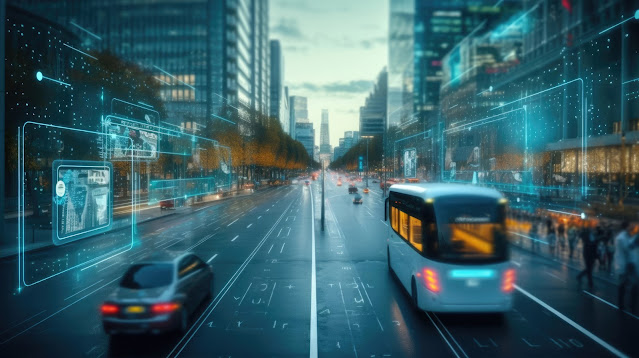Stuck in traffic? You're not alone. In 2022, the average American wasted 51 hours sitting in congestion, as per Forbes. This is a headache that the traffic management system (TMS) is working hard to cure.
Using a network of sensors, cameras, and computers, TMS monitors traffic conditions and makes real-time adjustments to keep things moving smoothly. But how exactly does it achieve that? These are the steps.Step 1: Data Collection
The first step for any TMS is to collect real-time data on traffic conditions. These systems gather this data through a network of sensors embedded in roads, bridges, and tunnels.These sensors can include:
Inductive Loop Detectors
These sensors lie buried beneath the road surface and use electromagnetic fields to detect vehicles passing overhead. They can track traffic volume and speed.Magnetometers
These sensors measure changes in the earth's magnetic field caused by metal objects like vehicles. They can detect traffic presence and volume.Video Cameras
High-definition video cameras equipped with image processing software can detect accidents and even near misses.Step 2: Data Analysis
Once the system collects the data, it feeds it into a central computer equipped with traffic management software. This software analyzes the data in real-time to identify trends and patterns in traffic flow.Here are some examples of what the software might identify:
Congested Roads
The software can identify roads with slow speeds and high traffic volume, indicating congestion.Recurring Bottlenecks
The software can analyze historical data to identify locations where congestion occurs frequently.Incidents
Video cameras can help identify accidents, disabled vehicles, or other incidents that are impacting traffic flow. This information feeds into road safety studies that help identify accident-prone areas and develop targeted safety measures.Step 3: Decision-Making
Based on the analyzed data from step two, the TMS software makes informed decisions to improve traffic flow. Here are a couple such strategies:Traffic Signal Optimization
The system can adjust traffic signal timings dynamically. Take the example of a typical four-way intersection. During rush hour, the TMS might extend the green light for the busier road. This allows for a smoother flow.Variable Speed Limit Signs
These electronic signs display speed limits that can adjust based on real-time traffic conditions. During heavy traffic, the TMS can lower the speed limit to encourage smoother traffic flow and prevent stop-and-go situations.Step 4: Implementation
Here, the decisions made in step three are translated into actions that directly impact traffic flow. Here's how the TMS puts the plan into effect:Traffic Signal Controllers
These devices manage traffic lights at intersections. The TMS communicates with these controllers to adjust signal timings based on the chosen strategy, like extending the green light for the road with heavy traffic due to the accident.Variable Message Signs (VMS)
These electronic signs display real-time traffic information to drivers. The TMS can update these signs with information about accidents, congestion, and suggested alternate routes.Step 5: Real-Time Traffic Information Dissemination
Once the TMS has implemented changes like signal timing adjustments or variable speed limits, it communicates these changes to drivers. Here's how:Variable Message Signs (VMS)
VMS signs strategically placed along roadways can display real-time information alerts about the bottlenecks ahead, updates on accidents or other disruptions, and alternative routes to avoid congestion.Travel Information Services
The TMS can feed data to third-party navigation apps and websites. This allows drivers to access real-time traffic information and plan their routes accordingly. For example, VMS signs along the highway leading away from the accident would be updated by the TMS to display a message like ‘Accident Ahead - Expect Delays - Use Detour.’This real-time information can help drivers make informed decisions about their routes, potentially avoiding congested areas and contributing to smoother overall traffic flow.
Step 6: Public Outreach and Education
Beyond immediate traffic updates, TMS can also play a role in educating the public about traffic management strategies and their benefits. This is totally possibly through:Public Service Announcements (PSAs)
These announcements can explain how the TMS works and the importance of following its directions, such as adhering to variable speed limits.Social Media Engagement
Traffic management agencies can use social media platforms to share real-time traffic information and educate the public about best practices when in congested areas.Step 7: Monitoring And Performance Measurement
After implementing changes, the TMS needs to monitor their effectiveness. This involves:- Traffic flow data: The system continues to collect data on traffic speeds, volume, and congestion levels.
- Travel time data: The TMS might track how long it takes vehicles to travel specific routes during different times of day.
- Public feedback: Feedback mechanisms can be established to allow drivers to report on their experience with the TMS adjustments.
By monitoring performance, the TMS can identify areas where further adjustments or strategies might be needed.
Step 8: System Evaluation and Optimization
Based on the data collected in step seven, the TMS undergoes continuous evaluation. Traffic management specialists analyze the data to determine:Effectiveness of implemented strategies: Did the adjustments like signal timing changes or variable speed limits achieve the desired outcome?
Identification of areas for improvement: Are there specific locations or times of day where congestion persists?
Through evaluation, the TMS identifies opportunities to refine its strategies and optimize traffic flow across the network.
Step 9: Continuous Improvement
As traffic patterns and infrastructure keep changing, the TMS needs to adapt, too. Here's how the system continuously improves:Software Updates
The software running the TMS is regularly updated with new algorithms and functionalities to better analyze traffic data and optimize strategies.Infrastructure Upgrades
In some cases, the TMS might recommend infrastructure upgrades like additional lanes or improved intersection design to address persistent congestion points.For example, based on the evaluation of the accident scenario, the TMS software might be updated with a new algorithm for dynamically adjusting traffic light timings at intersections with multiple feeder roads.
Additionally, the traffic management agency might recommend the construction of an additional turning lane at the accident-prone intersection to improve traffic flow in the long run.

No comments:
Post a Comment